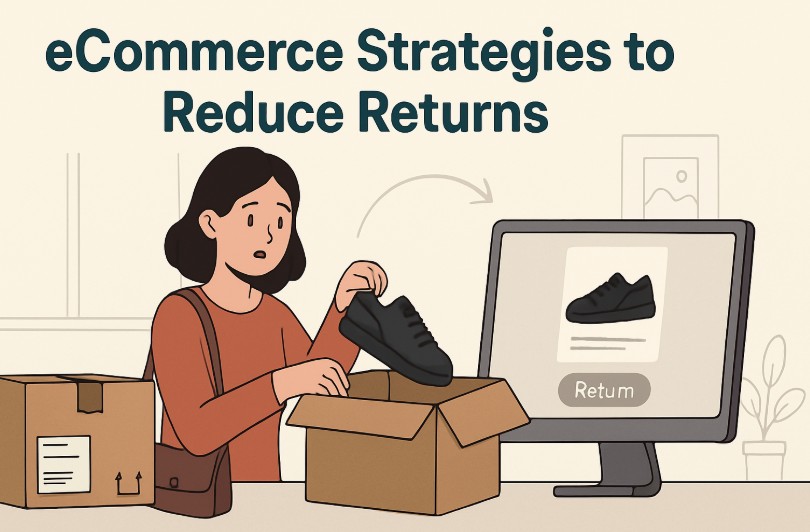
eCommerce Strategies to Reduce Returns You Can Leverage Today
Despite the many benefits online stores offer, product returns are unavoidable. According to Shopify, e-commerce return rates can range up to 30%. Why so high? Common reasons include wrong sizes, products that don’t match descriptions, or simply unmet expectations.
Returns don’t have to be a headache for your e-commerce business. With the right strategies, like using size chart Shopify integrations and leveraging customer reviews, you can reduce your return rate.
5 eCommerce Strategies to Reduce Returns
1. Provide Detailed Sizing Charts

Clothing is the most frequently returned item in online shopping. In a 2024 survey, 24% of U.S. respondents said they return clothing more than anything else. Common reasons for such high return rates include sizing issues, poor fit, and color differences.
A size chart helps your customers pick the right fit for clothes, shoes, and accessories when shopping online. It includes measurements for each size, making it easier for shoppers to choose accurately. The result? Fewer returns and a better shopping experience.
2. Write Clear Product Descriptions
Waiting weeks for a product only to find it’s not what you wanted is frustrating. Poor product descriptions are often to blame, costing sales and increasing returns.
About 31% of shoppers return items because they don’t match the description. If customers don’t clearly understand what they’re buying, they’re more likely to hesitate—or feel misled after purchasing.
Online shoppers can’t see or touch products before they buy, so clear, detailed descriptions are a must. Make sure your product descriptions are easy to read and give customers all the information they need to feel confident placing an order.
3. Improve Your Product Visuals
Good visuals allow customers to see the product more clearly and make confident decisions. Showcasing multiple product images from different angles and in various settings can help avoid surprises for customers when their order arrives.
Take at least four photos of every product—front, back, and sides. Use zoom to highlight details and make sure the images show the true color and features. If possible, add a video to show the product in action for a complete view.
4. Implement a Clear and Hassle-Free Return Policy

Make returns simple and stress-free to give customers confidence when they buy. A clear return policy builds trust. When creating your returns policy, consider the return period, outline any costs, and define what’s covered. Bonus points if you offer options like in-store returns for added convenience.
Also, make sure your policy is easy to find. 63% of shoppers won’t even consider buying if they can’t find clear return information on your website. Add the link to your return policy in key spots like product pages and tracking emails to keep things transparent and build trust.
5. Encourage Product Exchanges Over Returns
Make returns easy, and your customers will keep coming back. In fact, 72% of customers say a smooth return process makes them more likely to buy from a retailer again. So, don’t miss out on that opportunity.
One simple way to simplify the process while saving money is to encourage exchanges. For example, you can offer store credit when customers exchange items to build loyalty and increase repeat purchases. This keeps customers engaged and turns issues into opportunities.
Final Thoughts
Reducing returns in e-commerce is all about setting the right expectations and making the shopping experience as smooth as possible.
Help customers buy with confidence: use detailed sizing charts, clear descriptions, great visuals, and an easy return policy. While returns are inevitable, the right strategies can minimize their impact and keep your business growing.
Author Profile
- Blogger by Passion | Contributor to many Business Blogs in the United Kingdom | Fascinated to Write Blogs in Business & Startup Niches |
Latest entries
 BusinessMarch 26, 2025eCommerce Strategies to Reduce Returns You Can Leverage Today
BusinessMarch 26, 2025eCommerce Strategies to Reduce Returns You Can Leverage Today BusinessMarch 11, 2025The Future of Pharmaceutical Packaging
BusinessMarch 11, 2025The Future of Pharmaceutical Packaging BusinessFebruary 28, 2025SaaS Client Onboarding Challenges and How to Tackle Them?
BusinessFebruary 28, 2025SaaS Client Onboarding Challenges and How to Tackle Them? BusinessFebruary 28, 2025Interim Finance Managers: Why Hiring Them for your Business?
BusinessFebruary 28, 2025Interim Finance Managers: Why Hiring Them for your Business?

